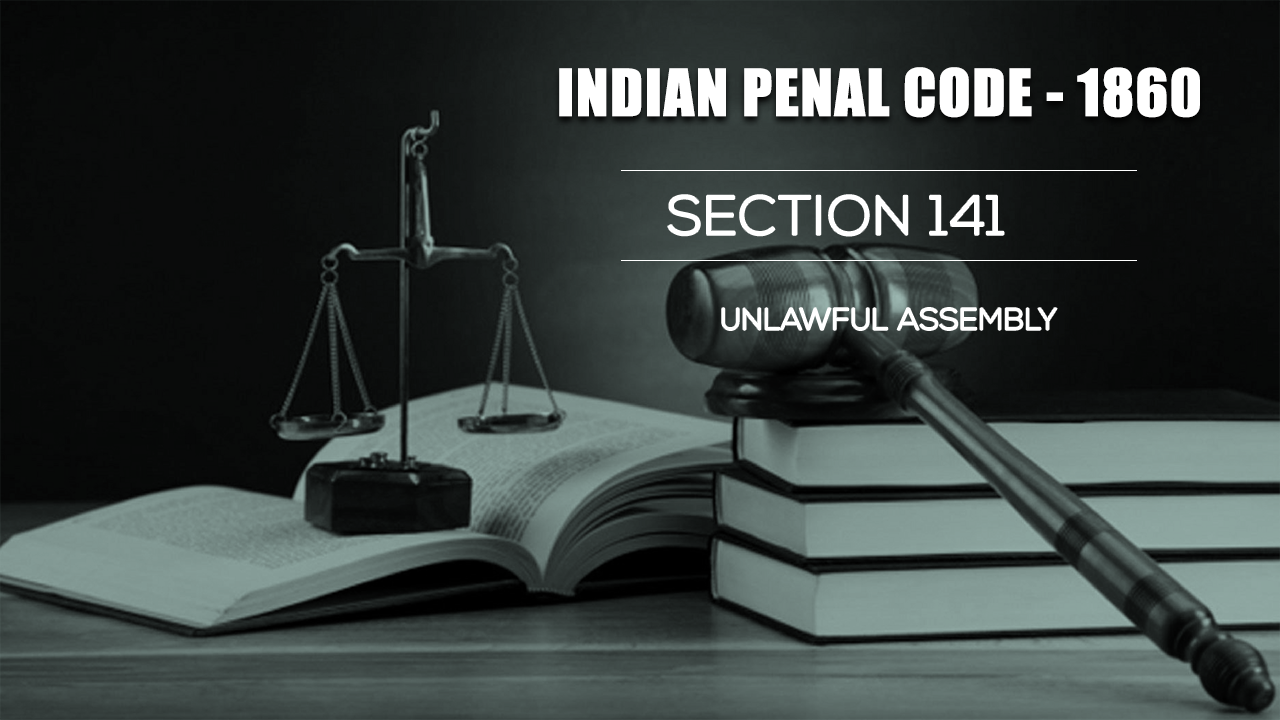Punishment for Unlawful Assembly - Section 141

Section 141 is mentioned in the Chapter VIII of the Indian Penal Code,1860. This chapter mentions Section 141 to Section 160. The offences in this chapter may be classified into the following four groups : Unlawful Assembly 1. Being a member of an unlawful assembly (Sections 141,142,143). Rioting (Section 146 and147) 1. Rioting with deadly weapons ( Section 148). 2. Assaulting or obstructing a public servant in the suppression of a riot ( Section 152). 3. Wantonly giving provocation with intent to cause riot ( Section 153). 4. Liability of the owner or occupier of land on which an unlawful assembly is held or a riot is committed (Section 154). 5. Liability of the person for whose benefit a riot is committed (Section 155). 6. Liability of the agent of owner or occupier for whose benefit a riot is committed (Section 156). Promoting enmity between different classes (Section 153 A). Affray (Section 159,160). Article 19 ((b) of the Indian Constitution confers the fundamental right to assemble peacefully and without arms. However, Section 141 of the IPC aims to criminalize unlawful assembly. An ‘Unlawful Assembly’ is an assembly of five or more persons if their common object is – To overawe, comply with any of the following powerful to abide by whatever you say by, criminal force (defined in Section 350 of IPC) 1. The Central Government, or 2. The State Government, or 3. The Legislature, or 4. Any public officer who is in the exercise of official power; To resist the execution of law or legal power. For example –The judgment of the case Indian Young Lawyer Association V. State of Kerala ( Sabarimala Case 2018), the judgment being that women between the age group of 10 to 50 years can enter the temple. Even after this judgment if anyone forms a group of more than five people and resists the entry of the woman of this age group into the temple, it will be known as an unlawful assembly. To commit mischief ( defined in Section 425 of IPC), criminal trespass (defined in Section 441 of IPC), or any other offence; By criminal force – a) To take or obtain possession of any property from a person; b) To deprive any person of any incorporeal right, these rights are the ones which do not have any physical existence and cannot be touched, it can only be perceived such as Patent rights, or c)  To enforce any right or supposed right; By criminal force to compel any person – a) To do what he is not legally bound to do, or b) To overlook and stop someone from doing something which he is legally entitled to do.What is Section 141 of IPC?
Main element-
There must be at least 5 people forming a group – A mere of 3 people with a common objective will not be called an ‘unlawful assembly’. The group has to have at least 5 members for it to be called an ‘unlawful assembly’ under Section 141 of IPC.
They must have a common object – the members of an unlawful assembly must have a common object to commit a particular offence.
Section 149 of IPC states some provisions related to common objective :
There must be an unlawful assembly.
An offence must be committed by any member of the unlawful assembly.
Such offence must have been committed in prosecution of the common objective of the assembly; or must be such as the members of the assembly knew to be likely to be committed.
Is IPC 141 bailable?
Yes, IPC Section 141 is bailable.
What is the punishment for IPC 141 Case?
The punishment for IPC Section 141 is described in Section 143 of the IPC. The punishment can be imprisonment which can be extended for up to 6 months or fine or even both.
Is IPC 141 a cognizable offence or a non-cognizable offence?
Yes, IPC 141 are cognizable offences which means can be tried under the jurisdiction of the Court, under the first class magistrate.
How to file/defend your case for IPC 141 offence?
Lawtendo is a law-tech company that has around 15000+ lawyers across India on our platform who can help you file/defend your case for IPC Section 141. Lawtendo aims to facilitate legal services/advice provided to the clients are cost-efficient and quality service. You can contact us at +91-967133666 or [email protected].
Famous Judgements related to Section 141
State V. Ishrat Jahan (2020) - The definition of Section 141 was reframed as an assembly that was not unlawful when it assembled, may subsequently become an unlawful assembly. As Section 141 there has to be at least 5 members and should have anyone or more than one common object as mentioned above, to constitute an unlawful assembly. The core of section 141 requires at least 5 people along with their common object. Being simply present with other members without any common objective does not amount to an unlawful assembly. Only by a mere presence of someone in the group of the people forming an unlawful assembly without any common object does it make him the member of the unlawful assembly.
Ramvir V. State of Uttar Pradesh ( 2018) – In this case, the Supreme Court had held that No Conviction under Section 148/149 of IPC should be accused in absence of at least 5 members with the same intention. The main point behind the arrest has to be that there were at least 5 persons forming a group with a common objective.
Mangal Singh V. State of Madhya Pradesh (1996) – In a free fight there cannot be said to be any form of an unlawful assembly and common intention. Each accused will be responsible for his individual act. If in an unlawful assembly 3 persons are acquitted and the rest could not be identified or are unmanned but the court is certain about the presence of other people in the group making the number to 5 or more than that, then, in that case, the section 141 will apply.
This beautiful article on IPC Section 141was drafted by Ms. Ishika Choudhary, BALLB – 2nd year, Amity Law School.
| Offence | Punishment | Cognizance | Bail | Triable By |
|---|---|---|---|---|
| Unlawful Assembly | Imprisonment up to 6 months or fine or both | Cognizable | Bailable | Any Magistrate |
| Offence | Unlawful Assembly |
|---|---|
| Punishment | Imprisonment up to 6 months or fine or both |
| Cognizance | Cognizable |
| Bail | Bailable |
| Triable By | Any Magistrate |


